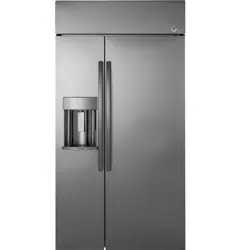Documents: Go to download!
- Owner's manual - (English, French)
- About the temperature controls.
- Ice and Water Dispenser (On some models)
- Care and cleaning of the refrigerator
- TROUBLESHOOTING TIPS
Table of contents
Owner's Manual GE Refrigerators
About the temperature controls.
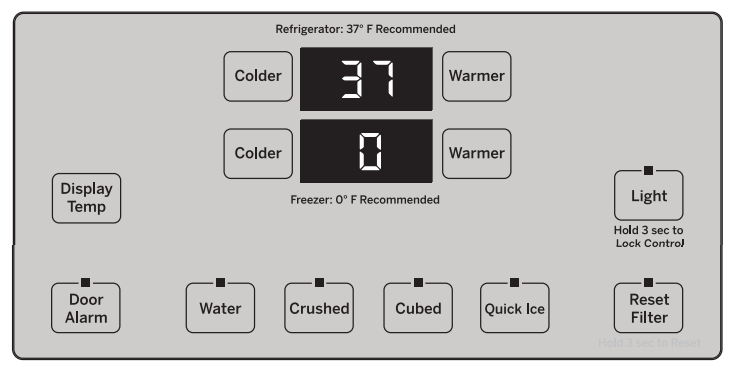
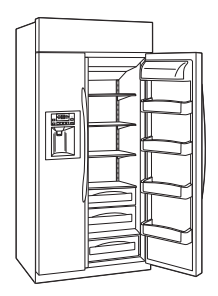 The temperature controls are preset in the factory at 37°F for the refrigerator compartment and 0°F for the freezer compartment. Allow 24 hours for the temperature to stabilize to the preset recommended settings.
The temperature controls are preset in the factory at 37°F for the refrigerator compartment and 0°F for the freezer compartment. Allow 24 hours for the temperature to stabilize to the preset recommended settings.
The temperature controls can display both the SET temperature as well as the actual temperature in the refrigerator and freezer.
The actual temperature may vary slightly from the SET temperature based on usage and operating environment.
NOTE: The refrigerator is shipped with protective film covering the temperature controls. If this film was not removed during installation, remove it now.
To change the temperature, press and release the WARMER or COLDER button. SET will illuminate in the display, as well as the set temperature. To change the temperature, tap either the WARMER or COLDER button
(while SET is illuminated) until the desired temperature is displayed. Refrigerator temperatures can be adjusted between 34°F and 47°F and the freezer temperatures can be adjusted between –6°F and +8°F.
Once the desired temperature has been set, the temperature display will clear after 10 seconds.
To display the temperature, the DISPLAY TEMP button may be tapped.
Several adjustments may be required. Each time you adjust controls, allow 24 hours for the refrigerator to reach the temperature you have set.
Performance Air Flow System
The Performance Air-Flow System is designed to maximize temperature control in the refrigerator and freezer compartments. This unique special feature consists of the Air Tower along the back wall of the refrigerator and the freezer. Placing food in front of the louvers on these components will not affect performance.
About ClimateKeeper® with dual evaporators.
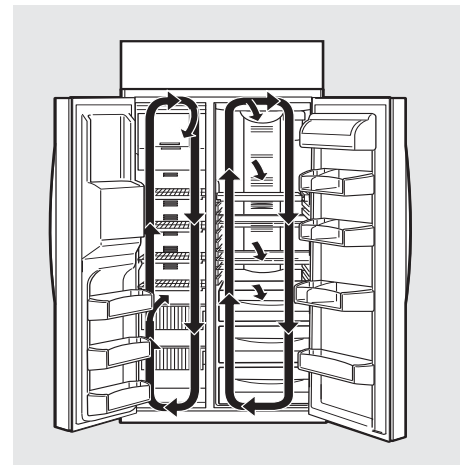
How it Works
The ClimateKeeper with dual evaporators system features two evaporators-one for the refrigerator and one for the freezer.
This provides two separate cooling systems, and separates the airflow between the fresh food and freezer compartments during normal cooling operations.
The separate airflow system minimizes the mixing of air between the two compartments, which reduces fresh food odor transfer to improve the taste of ice.
The ClimateKeeper system also reduces the number of defrosting cycles in the freezer evaporator, thereby reducing freezer burn.
About the water filter.
Water filter cartridge
The water filter cartridge is located in the back upper right corner of the refrigerator compartment.
When to replace the filter on models with a replacement indicator light
There is a replacement indicator light for the water filter cartridge on the dispenser. This light will turn orange to tell you that you need to replace the filter soon.
The filter cartridge should be replaced when the replacement indicator light turns red or if the flow of water to the dispenser or icemaker decreases.
When to replace the filter on models without a replacement indicator light
The filter cartridge should be replaced every six months or earlier if the flow of water to the dispenser or icemaker decreases.
Removing the filter cartridge
If you are replacing the cartridge, first remove the old one by slowly turning it to the left. Do not pull down on the cartridge. A small amount of water may drip down.
CAUTION: To reduce the risk associated with property damage due to water leakage, read and follow instructions before installation and use of this system. Installation and use MUST comply with all state and local plumbing codes.
Installing the filter cartridge
- Fill the replacement cartridge with water from the tap to allow for better flow from the dispenser immediately after installation.
- Line up the arrow on the cartridge and the cartridge holder. Place the top of the new cartridge up inside the holder. Do not push it up into the holder.
- Slowly turn it to the right until the filter cartridge stops. DO NOT OVERTIGHTEN. As you turn the cartridge, it will automatically raise itself into position. The cartridge will move about a ½ turn.
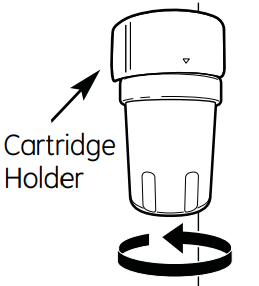
- Run water from the dispenser for 1-1/2 gallons (about three minutes) to clear the system and prevent sputtering.
- Press and hold the RESET WATER FILTER pad (on some models) on the dispenser for three seconds.
NOTE: A newly installed water filter cartridge may cause water to spurt from the dispenser.
Filter bypass plug
You must use the filter bypass plug when a replacement filter cartridge is not available. The dispenser and the icemaker will not operate without the filter or filter bypass plug.

To use the filter bypass plug on Water by Culligan™ models, you must first remove the filter adaptor from the cartridge holder by turning it to the left.
For the maximum benefit to your filtration system, GE recommends the use of GE-branded filters only. Using GE-branded filters in GE and Hotpoint® refrigerators provides optimal performance and reliability. GE filters meet rigorous industry NSF standards for safety and quality that are important for products that are filtering your water. GE has not qualified non-GE-branded filters for use in GE and Hotpoint refrigerators and there is no assurance that non-GE-branded filters meet GE's standards for quality, performance and reliability.
About the shelves and bins.
Not all features are on all models.
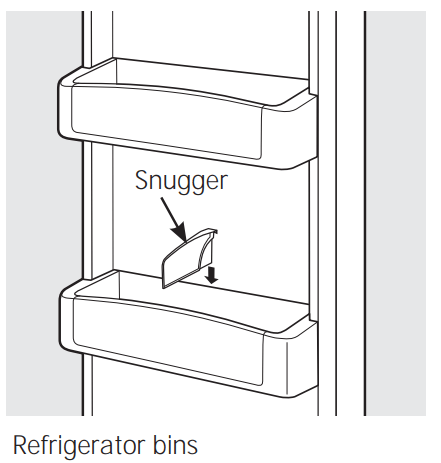
Refrigerator Door Bins and Freezer Door Bins
All door bins, except for the deep gallon door bin and freezer bins, are adjustable and can be moved up and down to meet your storage needs. The deep gallon door bin and the freezer bins can be removed for cleaning.
To remove any bin: Lift the bin up and pull it toward you.
To replace or relocate: Engage the back side of the bin in the molded supports on the door. Then push down on the front of the bin.
Bin will lock in place.
The snugger helps prevent tipping, spilling or sliding of small items stored on the door shelf. Place a finger on either side of the snugger near the rear and move it back and forth to fit your needs.

NOTE: Make sure that items do not block or fall into the ice chute.
Spillproof Shelves and Freezer Shelves

The special edges are designed to help prevent spills from dripping to lower shelves.
To remove shelves:
Tilt shelf up at front, then lift it up and out of tracks on rear wall of refrigerator.
To replace shelves:
Select desired shelf height. With shelf front raised slightly, engage top lugs in tracks at rear of cabinet. Then lower front of shelf until it locks into position.
Make sure you push the shelves all the way back in before you close the door.
About the refrigerator doors.
Refrigerator Doors

When the door is at 90° open, it will automatically close. Beyond this stop the door will stay open.
The refrigerator doors may feel different than The resistance you feel at the stop the ones you are used to. The secure door position will be reduced as the door
opening/closing feature makes sure the doors is loaded with food. close all the way and are securely sealed.
When opening and closing the door, you will notice a stop position. When the door is at the 90° stop position, it will automatically close.
Door Alignment
If doors are uneven, adjust the refrigerator door.
- Using a 7/32" socket wrench, turn the door adjusting screw clockwise to raise the door, counterclockwise to lower the door. (A nylon plug, imbedded in the threads of the pin, prevents the pin from turning unless a wrench is used.)
- After one or two turns of the wrench, open and close the refrigerator door and check the alignment at the top of the doors.
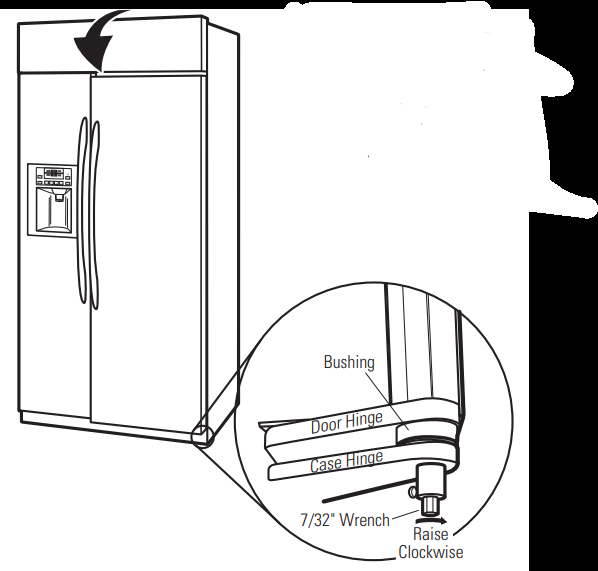
About the drawers and baskets.
Fruit and Vegetable Drawers
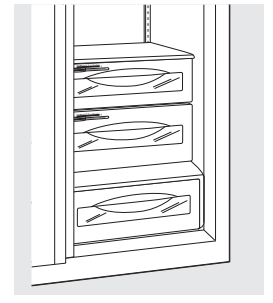
Excess water that may accumulate in the bottom of the drawers should be wiped dry.
Adjustable Humidity Drawers
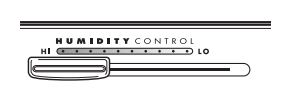
Slide the control all the way to the HI setting to provide high humidity recommended for most vegetables.
Slide the control all the way to the LO setting to provide lower humidity levels recommended for most fruits.
How to Remove and Replace the Drawers and Freezer Baskets
To remove fresh food drawers:
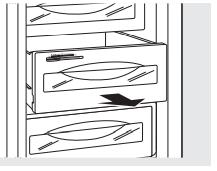
- Pull the desired drawer out to the stop position.
- Lift up slightly on the front of the drawer.
- Pull the drawer slightly forward and out of the refrigerator.
To replace fresh food drawers:
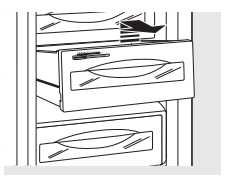
- Tip the back rollers of the drawer behind the rollers in the track.
- Lower the front of the drawer into normal position.
- Slide the drawer to the back of the refrigerator.
To remove freezer baskets:
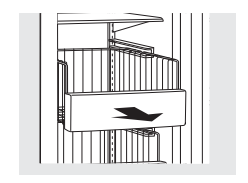
- Pull the desired basket out to the stop position.
- Lift up slightly on the front of the basket.
- Pull the basket slightly forward and out of the freezer.
To replace freezer baskets:

- Place the back corners in the rail with the basket tilted up.
- Lower the basket down to the normal position.
- Slide the basket to the back of the freezer.
About the ice and water dispenser and automatic icemaker.
A newly installed refrigerator may take 12 to 24 hours to begin making ice.
Ice Storage Bin
To remove:
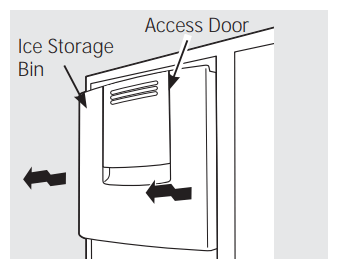
Lift up the access door to reach the icemaker. Set the icemaker power switch to the O (off) position. With the access door closed, support the storage bin at the bottom while slightly lifting. Pull bin straight out.
To replace:
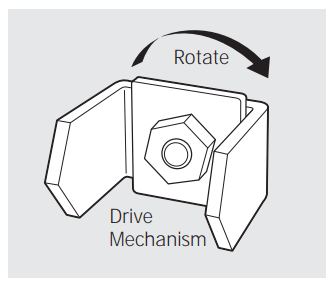
Slide the bin back until the tab on the bin locks into the slot on the shelf.
If the bin does not go all the way back, remove it and rotate the drive mechanism 1 /4 turn. Then push the bin back again.
Important facts about your ice and water dispenser
- Do not add ice from trays or bags to the storage bin. It may not crush or dispense well.
- Avoid overfilling glass with ice and use of narrow or extra-tall glasses. Backed-up ice can jam the chute or cause the door in the chute to freeze shut. If ice is blocking the chute, poke it through with a wooden spoon.
- Beverages and foods should not be quick-chilled in the ice storage bin. Cans, bottles or food packages in the storage bin may cause the icemaker or auger to jam.
- To keep dispensed ice from missing the glass, put the glass close to, but not touching, the dispenser opening.
- Some crushed ice may be dispensed even though you selected CUBED. This happens occasionally when a few cubes accidentally get directed to the crusher.
- After crushed ice is dispensed, some water may drip from the chute.
- The first glass of water dispensed may be warmer than the following ones. This is normal.
Automatic Icemaker
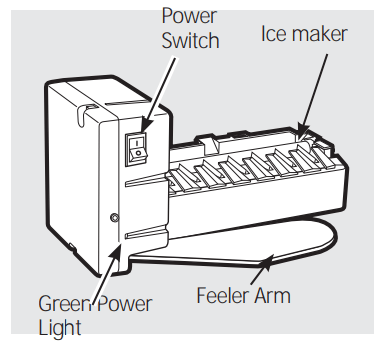
CAUTION Avoid contact with the moving parts of the ejector mechanism, or with the heating element (located on the bottom of the ice maker) that releases the cubes. Do not place fingers or hands on the automatic ice making mechanism while the refrigerator is plugged in.
A newly-installed refrigerator may take 12-24 hours to begin making ice.
The icemaker will produce seven cubes per cycle—approximately 15 cycles or more in a 24-hour period, depending on freezer compartment temperature, room temperature, number of door openings and other use conditions.
If the refrigerator is operated before the water connection is made to the icemaker, set the power switch to O (ofl).
When the refrigerator has been connected to the water supply, set the power switch to I (on). The green light will come on.
Throw away the first full bucket of ice.
Be sure nothing interferes with the sweep of the feeler arm.
When the bin fills to the level of the feeler arm, the icemaker will stop producing ice.
It is normal for several cubes to bejoined together.
If ice is not used frequently, old ice cubes will become cloudy, taste stale and shrink.
After the icemaker has been turned on again, there will be a delay of about 45 minutes before the icemaker resumes operations.
NOTE: In homes with lower-than-average water pressure, you may hear the icemaker water valve cycle on several times when making one batch of ice. Recommended water pressure is 60 psi.
Ice and Water Dispenser (On some models)
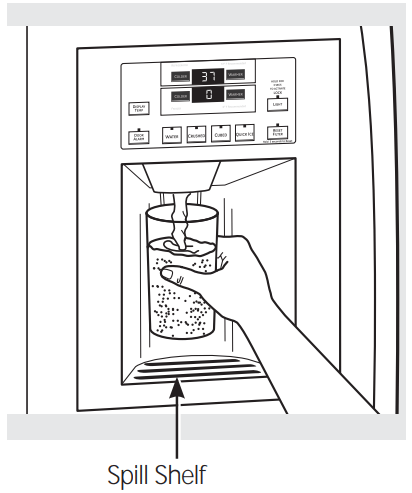
To Use the Dispenser
Select CUBED , CRUSHED
, CRUSHED  or WATER
or WATER
Press the glass gently against the middle of the dispenser pad.
The spill shelf is not self-draining. To reduce water spotting, the shelf and its grille should be cleaned regularly.
If no water is dispensed when the refrigerator is first installed, there may be air in the water line system. Press the dispenser arm for at least two minutes to remove trapped air from the water line and to fill the water system. To flush out impurities in the water line, throw away the first six glassfuls of water.
Locking the Dispenser
 Press the LIGHT button for 3 seconds to lock the dispenser and control panel. To unlock, press and hold the button again for 3 seconds.
Press the LIGHT button for 3 seconds to lock the dispenser and control panel. To unlock, press and hold the button again for 3 seconds.
Dispenser Light
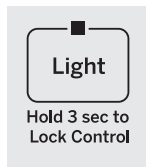 This button turns the light on the dispenser on and off. The light also comes on when the dispenser pad is pressed. If this light burns out, it should be replaced with a 6 watt 12V maximum bulb.
This button turns the light on the dispenser on and off. The light also comes on when the dispenser pad is pressed. If this light burns out, it should be replaced with a 6 watt 12V maximum bulb.
Quick Ice
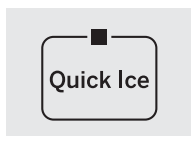 When you need ice in a hurry, press this button to speed up ice production. This will increase ice production for the following 48 hours or until you press the button again.
When you need ice in a hurry, press this button to speed up ice production. This will increase ice production for the following 48 hours or until you press the button again.
Door Alarm
 To turn the Door Alarm on, press the DOOR ALARM button once. The ACTIVE light will come on. To turn it off, press it again. When the DOOR ALARM is active, the ACTIVE light will flash if you open the door and beep if you keep the door open for more than 2 minutes. The light goes out and the beeping stops when you close the door.
To turn the Door Alarm on, press the DOOR ALARM button once. The ACTIVE light will come on. To turn it off, press it again. When the DOOR ALARM is active, the ACTIVE light will flash if you open the door and beep if you keep the door open for more than 2 minutes. The light goes out and the beeping stops when you close the door.
Care and cleaning of the refrigerator
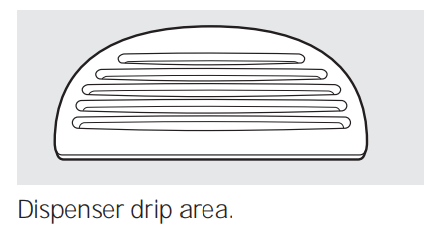
Cleaning the Outside
The spill shelf and the area beneath it should be cleaned periodically with a mild liquid dish detergent.
Dispenser pad. Before cleaning, lock the dispenser by pressing the LOCK/LIGHT button for 3 seconds to prevent activating the dispenser. Clean with warm water and a mild liquid dish detergent. Rinse thoroughly and wipe dry. Unlock the dispenser by pressing the LOCK/ LIGHT button for 3 seconds.
Door handles. Clean with a cloth dampened with soapy water. Dry with a soft cloth.
Do not wipe the refrigerator with a soiled dish cloth or wet towel. These may leave a residue that can damage the finish. Do not use scouring pads, powdered cleaners, bleach or cleaners containing bleach because these products can scratch and damage the finish.
The stainless steel doors and door handles
(on some models) can be cleaned with a commercially available stainless steel cleaner. Cleaners with oxalic acid such as Bar Keepers Friend Soft Cleanser™ will remove rust, tarnish and small blemishes. Use only a liquid cleanser free of grit and rub in the direction of the brush lines with a damp soft sponge. Do not use appliance wax or polish on the stainless steel.
Cleaning the Inside
Turn off power at the circuit breaker or fuse box before cleaning. If this is not practical, wring excess moisture out of sponge or cloth when cleaning around switches, lights or controls.
Use warm water and baking soda solution— about a tablespoon (15 ml) of baking soda to a quart (1 liter) of water. This both cleans and neutralizes odors. Thoroughly rinse and wipe dry.
Other parts of the refrigerator, including door gaskets, snack pan and vegetable drawers, ice storage bin and all plastic parts, can be cleaned the same way.
Do not wash the tray or any plastic refrigerator parts in the dishwasher.
CAUTION Do not clean glass shelves or covers with warm water when they are cold. Glass shelves and covers may break if exposed to sudden temperature changes or impact, such as bumping or dropping. Tempered glass is designed to shatter into many small pieces if it breaks.
Preparing for Vacation
For long vacations or absences, remove food and unplug the refrigerator. Clean the interior with a baking soda solution of one tablespoon (15 ml) of baking soda to one quart (1 liter) of water. Leave the doors open.
Set the icemaker power switch to the O (off) position and shut off the water supply to the refrigerator.
If the temperature can drop below freezing, have a qualified servicer drain the water supply system to prevent serious property damage due to flooding.
Preparing to Move
Secure all loose items such as shelves and drawers by taping them securely in place to prevent damage.
WARNING Due to the weight and size of this refrigerator, and to reduce the risk of personal injury or damage to the product, A MINIMUM OF 4 PEOPLE ARE REQUIRED TO BRING THE UNIT INTO THE HOME AND 2 PEOPLE ARE REQUIRED FOR PROPER INSTALLATION.
Be sure the refrigerator stays in an upright position during moving.
Replacing the light bulbs.
Setting the controls to OFF does not remove power to the light circuit.
Refrigerator Compartment-Upper Light
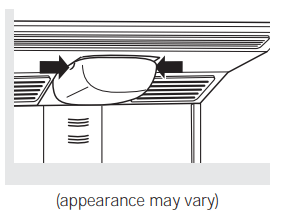
CAUTION Light bulbs may be hot. Burned out bulbs may break when being replaced.
- Raise the grille panel, set the master power switch to the O (off) position and allow lamps to cool.
- To remove the light shield, press on the sides of the shield and pull down.
- Replace the bulbs with appliance bulbs of the same or lower wattage. Replace the shield by engaging the bottom tab into the slot and applying light forward pressure until the shield snaps in place.
- Set the master power switch to the I (on) position and close the grille panel.
Refrigerator Compartment-Lower Light
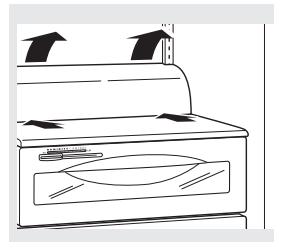
This light is located above the top drawer,
- Raise the grille panel, set the master power switch to the O (off) position and allow lamps to cool.
- Remove items from the shelf above the light shield. Remove the shelf.
- Use both hands to grasp each end of the light shield. Press in on the bottom of the shield with your thumbs while rotating the cover up and out.
- Replace the bulb with an appliance bulb of the same or lower wattage. Replace the shield by engaging the bottom tab into the slot and applying light forward pressure until the shield snaps in place.
- Set the master power switch to the I (on) position and close the grille panel.
Freezer Compartment
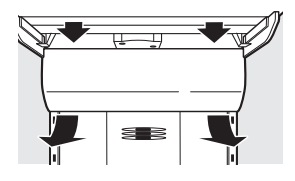
- Raise the grille panel, set the master power switch to the O (off) position and allow lamps to cool. & Remove the items from the shelfjust below the light shield. Remove the shelf.
- To remove the light shield, press down on the top of the shield and pull the tabs out of the slots. Tilt the shield forward and out.
- Replace the bulb with an appliance bulb of the same or lower wattage, and reinstall the light shield. Replace the shield by engaging the bottom tab into the slot and applying light forward pressure until the shield snaps in place.
- Set the master power switch to the I (on) position and close the grille panel.
Dispenser
- Raise the grille panel, set the master power switch to the O (off) position and allow lamps to cool.
- The bulb is located in the dispenser under the control panel. Remove the two screws from the light shield. lide the light shield toward the dispenser to disengage the tabs, then remove the light shield. Remove the light bulb by turning it counterclockwise.
- Replace the bulb with a bulb of the same size and wattage. Replace the light shield by sliding the tabs into the slots in the front of the dispenser. Replace the two screws.
- Set the master power switch to the I (on) position and close the grille panel.
TROUBLESHOOTING TIPS
Normal Operating Sounds
Newer refrigerators sound different from older refrigerators. Modern refrigerators have more features and use newer technology
Do you hear what I hear? These sounds are normal.
HUMMM... WHOOSH...
The new high efficiency compressor may run faster and longer than your old refrigerator and you may hear a high-pitched hum or pulsating sound while it is operating.
You may hear a whooshing sound when the doors close. This is due to pressure equalizing within the refrigerator.
WHIR! 
- You may hear the fans spinning at high speeds. This happens when the refrigerator is first plugged in, when the doors are opened frequently or when a large amount of food is added to the refrigerator or freezer compartments. The fans are helping to maintain the correct temperatures.
- If either door is open for over 3 minutes, you may hear the fans come on in order to cool the light bulbs
- The fans change speeds in order to provide optimal cooling and energy savings.
CLICKS, POPS, CRACKS and CHIRPS
- You may hear cracking or popping sounds when the refrigerator is first plugged in. This happens as the refrigerator cools to the correct temperature.
- The compressor may cause a clicking or chirping sound when attempting to restart (this could take up to 5 minutes).
- The electronic control board may cause a clicking sound when relays activate to control refrigerator components.
- Expansion and contraction of cooling coils during and after defrost can cause a cracking or popping sound.
- The fans change speeds in order to provide optimal cooling and energy savings.
WATER SOUNDS 
- The flow of refrigerant through the freezer cooling coils may make a gurgling noise like boiling water.
- Water dropping on the defrost heater can cause a sizzling, popping or buzzing sound during the defrost cycle.
- A water dripping noise may occur during the defrost cycle as ice melts from the evaporator and flows into the drain pan.
- Closing the door may cause a gurgling sound due to pressure equalization.
Troubleshooting Tips...
Save time and money! Review the charts on the following pages first and you may not need to call for service.
Problem | Possible Causes | What To Do |
Refrigerator does not operate | Refrigerator in defrost cycle. |
|
Master power control set to OFF. |
| |
Refrigerator is unplugged. |
| |
The fuse is blown/circuit breaker is tripped. |
| |
Refrigerator is in showroom mode. |
| |
Vibration or rattling (slight vibration is normal) | Refrigerator is not level |
|
Motor operates for long periods or cycles on and off frequently. (Modern refrigerators with more storage space and a larger freezer require more operating time. They start and stop often to maintain even temperatures.) | Normal when refrigerator is first plugged in. |
|
Often occurs when large amounts of food are placed in refrigerator. |
| |
Door left open. |
| |
Hot weather or frequent door openings. |
| |
Temperature controls set at the coldest setting. |
| |
Refrigerator or freezer compartment too warm | Temperature control not set cold enough. Warm weather or frequent door openings. |
|
Door left open. |
| |
Frost or ice crystals on frozen food (frost within package is normal) | Door left open. |
|
Too frequent or too long door openings. |
| |
Divider between refrigerator and freezer compartments feels warm | Automatic energy saver system circulates warm liquid around front edge of freezer compartment. |
|
Automatic icemaker does not work | Icemaker switch is in the OFF position. |
|
Water supply turned off or not connected. |
| |
Freezer compartment too warm. |
| |
Piled up cubes in the storage bin cause icemaker to shut off. |
| |
Ice cubes stuck in icemaker.(Green power light on icemaker blinking) |
| |
Frequent "buzzing" sound | Icemaker power switch is in the I (on) position, but the water supply to the refrigerator has not been connected. |
|
Ice cubes have odor/taste | Ice storage bin needs cleaning. |
|
Food transmitting odor/taste to ice cubes. |
| |
Interior of refrigerator needs cleaning. |
| |
Small or hollow cubes | Water filter clogged. |
|
Slow ice cube freezing | Door left open. |
|
Temperature control not set cold enough. |
| |
Cube dispenser does not work | Icemaker turned off or water supply turned off. |
|
An item is blocking or has fallen into the ice chute inside the top door bin of the freezer. |
| |
Ice cubes are frozen to icemaker feeler arm. |
| |
Irregular ice clumps in storage container. |
| |
Dispenser is LOCKED. |
| |
Water has poor taste/odor | Water dispenser has not been used for a long time. |
|
Water in First glass is warm | Normal when refrigerator is first installed. |
|
Water dispenser has not been used for a long time. |
| |
Water system has been drained. |
| |
Water dispenser does not work | Water supply line turned off or not connected. |
|
Water filter clogged. |
| |
Air may be trapped in the water system. |
| |
Dispenser is LOCKED. |
| |
Refrigerator control setting is too cold. |
| |
Water spurting from dispenser | Newly-installed filter cartridge. |
|
Water is not dispensed but icemaker is working | Water in reservoir is frozen. |
|
Refrigerator control setting is too cold. |
| |
No water or ice cube production | Supply line or shutoff valve is clogged. |
|
Water filter clogged. |
| |
Dispenser is LOCKED. |
| |
CUBED was selected but CRUSHED was dispensed | Last setting was CRUSHED. |
|
Orange glow in the freezer | Defrost heater is on. |
|
Refrigerator has odor | Foods transmitting odor to refrigerator. |
|
Interior needs cleaning. |
| |
Door not closing properly | Door gasket on hinge side sticking or folding over. |
|
A door bin is hitting a shelf inside the refrigerator. |
| |
Refrigerator is not level. |
| |
Moisture forms on outside of refrigerator | Not unusual during periods of high humidity. |
|
Moisture collects inside (in humid weather, air carries moisture into refrigerator when doors are opened) | Too frequent or too long door openings. | |
Interior light does not work | No power at outlet. |
|
Light bulb burned out. |
| |
Water on kitchen floor or on bottom of freezer | Cubes jammed in chute. |
|
Hot air from top of refrigerator | Normal air flow cooling motor. In the refrigeration process, it is normal that heat be expelled in the area above the refrigerator. | |
Refrigerator never shuts off, but the temperatures are OK | Adaptive defrost keeps compressor running during door openings. |
|
Refrigerator beeping | Door open. |
|
Actual temperature not equal to Set temperature | Unitjust plugged in. |
|
Door open for too long. |
| |
Warm food added to refrigerator. |
| |
Defrost cycle is in process. |
| |
See other models: FUM14SVDRWW GTX42GASJ1WW PSC23NHMCWW GTS17BBMBLAA GTH18EBT2RBB
